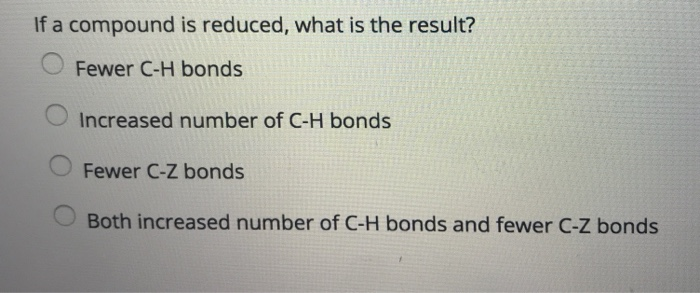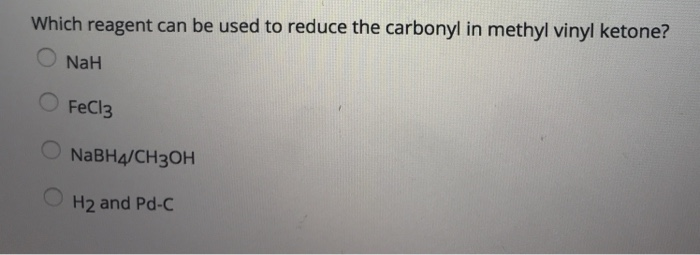QQuestionAnatomy and Physiology
QuestionAnatomy and Physiology
If a compound is reduced, what is the result?
Fewer C-H bonds
Increased number of C-H bonds
Fewer C-Z bonds
Both increased number of C-H bonds and fewer C-Z bonds
Which of the following terms explain why aldehydes are more reactive than ketones?
$\bigcirc$ Hybridization and resonance
$\bigcirc$ Electronegativity and resonance
$\bigcirc$ Electronegativity and hybridization
$\bigcirc$ Sterics and electronics
Which reagent can be used to reduce the carbonyl in methyl vinyl ketone?
$\mathrm{NaH}$
$\mathrm{FeCl}_{3}$
$\mathrm{NaBH}_{4} / \mathrm{CH}_{3} \mathrm{OH}$
$\mathrm{H}_{2}$ and Pd-C
What reagent would be used to reduce an amide to an amine?
- NaBH₄
- LiAlH(OtBu)₃
- FeCl₃
- LiAlH₄
What is the name of the general reaction type that carboxylic acids, esters, and amides undergo?
- Nucleophilic acyl addition
- Electrophilic acyl substitution
- Nucleophilic acyl substitution
- Electrophilic acyl addition
Attachments





6 months agoReport content
Answer
Full Solution Locked
Sign in to view the complete step-by-step solution and unlock all study resources.
Step 1**Problem 1:** If a compound is reduced, what is the result?
Step 2: Understand the process of reduction in organic chemistry.
Reduction generally involves gaining hydrogen or losing oxygen. In the context of this question, we are looking at the impact on C-H and C-Z bonds (where Z is some other atom).
Final Answer
**Problem 2:** Which of the following terms explain why aldehydes are more reactive than ketones? Step 1: Identify the key difference between aldehydes and ketones. Aldehydes have a hydrogen atom attached to the carbonyl carbon, while ketones have another carbon atom attached to the carbonyl carbon. Step 2: Analyze the options. - Hybridization and resonance: This is not the correct explanation, as both aldehydes and ketones have the same hybridization (sp²) and do not have resonance structures. - Electronegativity and resonance: Resonance is not a factor here, but electronegativity plays a role in the difference in reactivity. However, it is not the only factor. - Electronegativity and hybridization: This is not the correct explanation, as both aldehydes and ketones have the same hybridization (sp²). - Sterics and electronics: Sterics are not a significant factor in this case, but electronics (electronegativity) is a factor. Step 3: Choose the most accurate answer. - Electronegativity and hybridization This answer is not entirely correct, as hybridization is not a factor in this case. However, it is more accurate than the other options. **Problem 3:** Which reagent can be used to reduce the carbonyl in methyl vinyl ketone? Step 1: Identify the compound and its functional groups. Methyl vinyl ketone has a carbonyl group (C=O) and a carbon-carbon double bond (C=C). Step 2: Analyze the options. - NaH: This is a strong base, not a reducing agent. - FeCl₃: This is an oxidizing agent, not a reducing agent. - NaBH₄/CH₃OH: This is a reducing agent that can donate hydride ions (H:⁻) to reduce carbonyl groups. - H₂ and Pd-C: This is a reducing agent that can donate hydrogen atoms (H•) to reduce carbonyl groups. Step 3: Choose the most appropriate reagent. - NaBH₄/CH₃OH **Problem 4:** What reagent would be used to reduce an amide to an amine? Step 1: Identify the compound and its functional group. An amide has a carbonyl group (C=O) bonded to a nitrogen atom. Step 2: Analyze the options. - NaBH₄: This is a strong reducing agent, but it is not strong enough to reduce an amide to an amine. - LiAlH(OtBu)₃: This is a strong reducing agent that can donate hydride ions (H:⁻) to reduce amides to amines. - FeCl₃: This is an oxidizing agent, not a reducing agent. - LiAlH₄: This is a strong reducing agent that can donate hydride ions (H:⁻) to reduce amides to amines. Step 3: Choose the most appropriate reagent. - LiAlH₄ **Problem 5:** What is the name of the general reaction type that carboxylic acids, esters, and amides undergo? Step 1: Identify the common functional group in carboxylic acids, esters, and amides. They all have a carbonyl group (C=O) bonded to another atom (oxygen, oxygen, or nitrogen, respectively). Step 2: Analyze the options. - Nucleophilic acyl addition: This is not the correct answer, as it refers to a reaction where a nucleophile attacks the carbonyl carbon from the side. - Electrophilic acyl substitution: This is not the correct answer, as it refers to a reaction where a nucleophile replaces a leaving group on the carbonyl carbon. - Nucleophilic acyl substitution: This is the correct answer, as it refers to a reaction where a nucleophile replaces a group (usually a leaving group) on the carbonyl carbon through a substitution mechanism. - Electrophilic acyl addition: This is not the correct answer, as it refers to a reaction where an electrophile adds to the carbonyl carbon. Step 3: Choose the most appropriate answer. - Nucleophilic acyl substitution
Need Help with Homework?
Stuck on a difficult problem? We've got you covered:
- Post your question or upload an image
- Get instant step-by-step solutions
- Learn from our AI and community of students